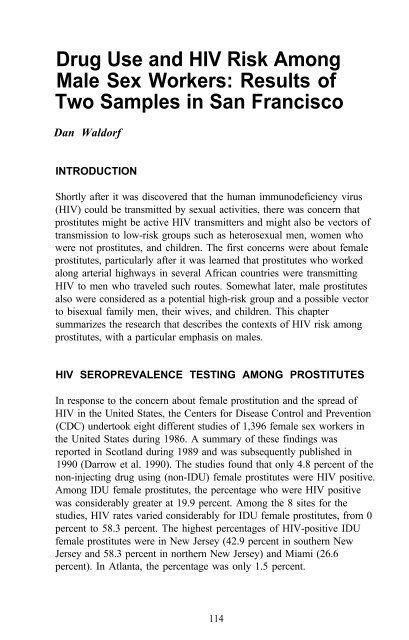The Context of HIV Risk Among Drug Users and Their Sexual Partners
The Context of HIV Risk Among Drug Users and Their Sexual Partners
The Context of HIV Risk Among Drug Users and Their Sexual Partners
You also want an ePaper? Increase the reach of your titles
YUMPU automatically turns print PDFs into web optimized ePapers that Google loves.
<strong>Drug</strong> Use <strong>and</strong> <strong>HIV</strong> <strong>Risk</strong> <strong>Among</strong><br />
Male Sex Workers: Results <strong>of</strong><br />
Two Samples in San Francisco<br />
Dan Waldorf<br />
INTRODUCTION<br />
Shortly after it was discovered that the human immunodeficiency virus<br />
(<strong>HIV</strong>) could be transmitted by sexual activities, there was concern that<br />
prostitutes might be active <strong>HIV</strong> transmitters <strong>and</strong> might also be vectors <strong>of</strong><br />
transmission to low-risk groups such as heterosexual men, women who<br />
were not prostitutes, <strong>and</strong> children. <strong>The</strong> first concerns were about female<br />
prostitutes, particularly after it was learned that prostitutes who worked<br />
along arterial highways in several African countries were transmitting<br />
<strong>HIV</strong> to men who traveled such routes. Somewhat later, male prostitutes<br />
also were considered as a potential high-risk group <strong>and</strong> a possible vector<br />
to bisexual family men, their wives, <strong>and</strong> children. This chapter<br />
summarizes the research that describes the contexts <strong>of</strong> <strong>HIV</strong> risk among<br />
prostitutes, with a particular emphasis on males.<br />
<strong>HIV</strong> SEROPREVALENCE TESTING AMONG PROSTITUTES<br />
In response to the concern about female prostitution <strong>and</strong> the spread <strong>of</strong><br />
<strong>HIV</strong> in the United States, the Centers for Disease Control <strong>and</strong> Prevention<br />
(CDC) undertook eight different studies <strong>of</strong> 1,396 female sex workers in<br />
the United States during 1986. A summary <strong>of</strong> these findings was<br />
reported in Scotl<strong>and</strong> during 1989 <strong>and</strong> was subsequently published in<br />
1990 (Darrow et al. 1990). <strong>The</strong> studies found that only 4.8 percent <strong>of</strong> the<br />
non-injecting drug using (non-IDU) female prostitutes were <strong>HIV</strong> positive.<br />
<strong>Among</strong> IDU female prostitutes, the percentage who were <strong>HIV</strong> positive<br />
was considerably greater at 19.9 percent. <strong>Among</strong> the 8 sites for the<br />
studies, <strong>HIV</strong> rates varied considerably for IDU female prostitutes, from 0<br />
percent to 58.3 percent. <strong>The</strong> highest percentages <strong>of</strong> <strong>HIV</strong>-positive IDU<br />
female prostitutes were in New Jersey (42.9 percent in southern New<br />
Jersey <strong>and</strong> 58.3 percent in northern New Jersey) <strong>and</strong> Miami (26.6<br />
percent). In Atlanta, the percentage was only 1.5 percent.<br />
114
















